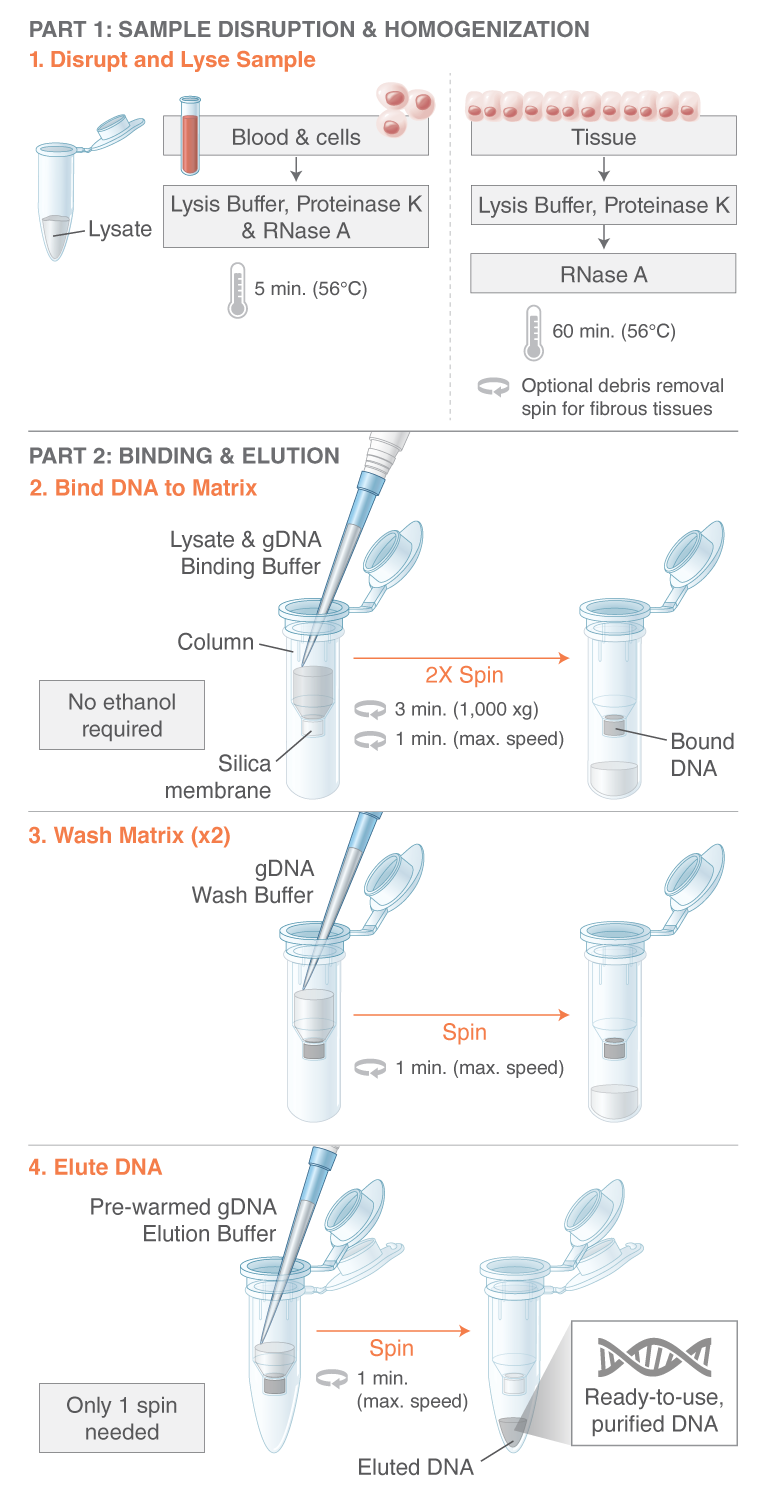What is the PCR and How to Get a Purified PCR Product?
Polymerase chain reaction (PCR) is a laboratory technique that’s widely used to make millions or billions of copies of your target DNA in vitro.
Why do we need so many DNA?
The amplified DNA can be visualized on a gel and enable us to determine the presence/absence of target DNA in the sample or it can be purified and used for various downstream applications. One of the most popular applications is matching the crime scene DNA with the suspect’s DNA. Other than that, you can use PCR or purified PCR products for::
- GMO testing
- Gene cloning
- Viral bacterial infection
- Genotyping
- Gene expression
- Phylogenetic Evolution, etc.
The next question is, how can you perform PCR and subsequently obtain purified PCR products?
Well, you can get the purified PCR products from any sample types in just 4 steps. They are:
- DNA Extraction: Template Preparation
- DNA Amplification: Polymerase Chain Reaction (PCR) to increase the number of target DNA
- Gel Electrophoresis: To Verify the Presence of DNA of Interest
- PCR Cleanup: Preparation of Purified DNA for Downstream Applications
1. DNA Extraction: Template Preparation
The first and the most important thing that you need before running a PCR is… Your DNA template!
And you might be thinking, “How to extract DNA from my sample?”
Don’t worry, we’ll explain here.
DNA extraction can be done in 4 steps:
- Lysis
- Binding
- Washing
- Elution
Lysis and washing steps are the most important steps of the four. Lysis involves the break down of the membrane to release the nuclear DNA and washing buffer is used to remove unwanted cellular components, cell debris and contaminants (environmental samples). To obtain the best result, specific kit with different lysis and wash buffers are used to handle different sample types.
Hence, for a smarter way, you can use a commercialized DNA purification kit, such as Monarch® Genomic DNA Purification Kit to handle most of the samples. This kit provides all the required reagents and kits that make the process of DNA extraction easy and smooth. It is suitable to extract DNA from cells, blood, tissues (including fatty and fibrous tissue), some tough to lyse sample (eg. Bacteria and yeast) or clinically-relevant sample (eg. Saliva, cheek).
By using this kit, you can easily obtain excellent yields of highly pure DNA with extremely low RNA contamination (<1%). Moreover, you can isolate high molecular weight gDNA (peak size typically more than 50kb) which is great for applications that required long intact genomic DNA..
For more tips about using Monarch® Genomic DNA Purification Kit, please visit Nucleic Acid Purification Kits for DNA and RNA.

Figure above illustrates the workflow for Monarch Genomic DNA Purification kits. Source: https://international.neb.com/monarch/monarch-nucleic-acid-purification-kits
DNA Extraction from Environmental, Plant, Soil, Stool, Teeth and Bone Sample
However, it is challenging to isolate high-quality and large quantity of DNA from some sources, especially from environmental, plant, soil, stool, teeth and bone.
Why it is hard to isolate DNA from these sources?
There are two common factors which led to poor DNA isolation:
- Incomplete lysis of sample that leads to low yield of DNA, and
- High amount of contaminants in the tough sample. Contaminants such as humic acid and polyphenols can interact with nucleic acids during DNA isolation. This usually leads to failure in downstream applications.
To further improve the yield and quality of the DNA from these sources, you can isolate the DNA with FastDNA SPIN Kit for Soil and the homogenizer, FastPrep-24TM 5G Instrument. It has been proven in over 6000+ scientific publication that FastDNA Spin Kit for Soil delivers high quality and high yield of DNA from the sources mentioned previously.
DNA Extraction from a Large Amount of Sample
If you are the one who needs to extract DNA from a large number of samples, it would be laborious and time-consuming. Besides, repetitive pipetting action could possibly strain your muscle and causing RSI (Repetitive Strain Injury).
You would definitely need an automated, or at least a semi-automated DNA extraction machine. abGenix from AITbiotech is a semi-automated DNA extraction machine that can extract DNA from 32 samples in just 30 mins. Save your valuable time and make your work more effective. Due to its ease of use, abGenix provides rapid extraction of high-quality nucleic acid as well as being user-friendly.
Just in case, if you need to preserve and stabilize your RNA and DNA during the transportation and extraction of your sample, we would recommend you to use Monarch® DNA/RNA Protection Reagent. It can help to prevent the degradation of nucleic acid.
2. DNA Amplifications: Polymerase Chain Reaction (PCR)
After you have purified your DNA template, the DNA is ready for the next step, Polymerase Chain Reaction (PCR). PCR involves various stages, including denaturation, annealing and extension. All these processes can be done by using abCycler (AITbiotech), a thermal cycler.
Before PCR, you have to ensure that you have the following reagents:
- Taq DNA Polymerase
- dNTP Mix
- Magnesium Chloride
- Buffer
In the old days, scientists need to purchase these items individually. Fortunately, PCR Mastermixes are available now. New England Biolabs (NEB) offers a variety of PCR Mastermixes and reagents that allow you to perform PCR easily. What you need to prepare is the primers and DNA templates, then you are ready to go for PCR.
What are the Available DNA Polymerases?
Q5® DNA Polymerase is a high-fidelity DNA polymerase, which is around 280x more accurate than Taq®. Q5® is normally used in ultra-high fidelity PCR, long-range PCR, SNP analysis via cloning, NGS library prep, etc.
OneTaq® is another type of DNA polymerase. It is 2x more accurate than Taq® and is normally sufficient for routine and colony PCR.
On the other hand, if you are looking for a more affordable alternative for routine PCR, Taq® DNA polymerase would be an excellent choice for you.
LongAmp® is a type of DNA polymerase that can amplify up to 30kb amplicon. On top of that, it is 2x more stable compare to Taq® DNA polymerase. Hence, if you are doing long-range or colony PCR, LongAmp® is best suited for your application.
You can choose WarmStart LAMP Kit® (DNA & RNA) or WarmStart Colorimetric LAMP 2X Master Mix (DNA & RNA) for Loop-mediated isothermal amplification (LAMP) application. LAMP is another type of PCR method which is highly specific as it utilizes 4-6 primers in PCR. Besides, it is highly sensitive and provides results rapidly, you can expect to see the results in just 5 mins. In addition, you would not need to use any expensive equipment, such as a PCR machine to view the results. You can incubate the sample in a water bath and visualize the results using your naked eye. If you observe the formation of a white magnesium pyrophosphate precipitate at the end of the LAMP, then you get a positive result. As LAMP is cost-effective, making it extremely suitable for use in the field diagnostic.
You can refer to What is DNA Polymerase and Its function for more information.
3. Gel Electrophoresis: To Verify the Presence of DNA of Interest
After DNA amplification, you would think, “How can I ensure that I was amplifying the right DNA? What if I was amplifying the wrong one?”
No worry! You can check your DNA of interest by using gel electrophoresis. Gel electrophoresis is a pretty simple and cost-effective technique to examine the presence of the DNA band.
What do you need for gel electrophoresis?
All you need is just:
- Horizontal Gel Electrophoresis unit (Cleaver Scientific)
- Lonza™ SeaKem™ LE Agarose
- TAE Buffer
- TBE Buffer
- GelStar Stain
- Loading dye (NEB)
- Gel documentation system
For more information about gel electrophoresis, please visit What is Gel Electrophoresis?
Some of you might think, “Urrrghhh, it’s so tedious and time-consuming to run gel electrophoresis, is there any other gel system that can save my time and easy to do?”
Yes, we have! Flash Gel System from Lonza can separate your DNA in just as little as 5 minutes. Due to the high sensitivity of this system, it allows a reduction of 5-20x in DNA concentration – saving both your precious time and sample.
On top of that, you can directly recover the DNA of interest without any band excision or purification. What’s more interesting is, you can see the DNA migration as it happens, making it an excellent gel system for teaching purpose. Using Lonza Flash Gel System, you would not worry about the harmful UV light anymore, as Lonza FlshGel System utilizes blue light to view the DNA bands.
4. PCR Cleanup: Preparation of Purified DNA for Downstream Applications
After running gel electrophoresis, you know that your DNA of interest is there, and you want to get your DNA ready for the downstream applications.
There are a few ways to do so:
- Purify the PCR products by removing the unwanted components from the PCR products using Exo-CIP™ Rapid PCR Cleanup Kit in 4 mins. It helps to destroy primers and dNTPs and suitable for the downstream application like DNA sequencing.
- Purify your PCR product using Monarch® PCR & DNA Cleanup Kit and get purified PCR products (DNA). The purified PCR products are suitable for any downstream application.
- If there is more than one DNA band in the gel, you can excise the DNA of interest directly from the gel and purify them using Monarch DNA Gel Extraction kit. After the DNA is purified, you can proceed to the downstream application.
Conclusion
In short, we have discussed how to get a purified PCR product, from:
DNA Extraction -> DNA Amplification -> Gel Electrophoresis -> PCR Cleanup
In each stage, we have recommended suitable products that could help you to get the best results.



